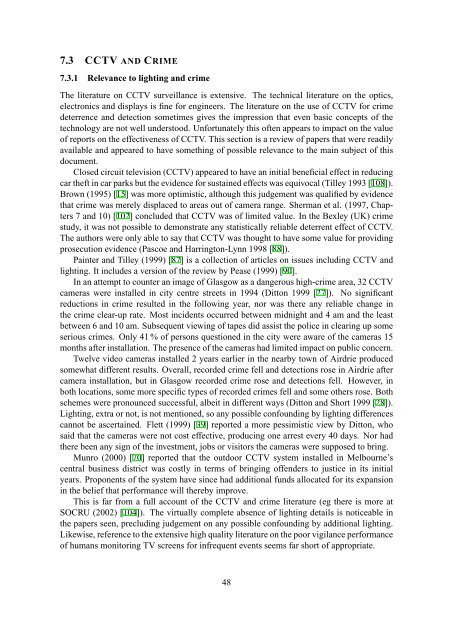outdoor lighting and crime, part 1 - Astronomical Society of Victoria
outdoor lighting and crime, part 1 - Astronomical Society of Victoria
outdoor lighting and crime, part 1 - Astronomical Society of Victoria
Create successful ePaper yourself
Turn your PDF publications into a flip-book with our unique Google optimized e-Paper software.
7.3 CCTV AND CRIME<br />
7.3.1 Relevance to <strong>lighting</strong> <strong>and</strong> <strong>crime</strong><br />
The literature on CCTV surveillance is extensive. The technical literature on the optics,<br />
electronics <strong>and</strong> displays is fine for engineers. The literature on the use <strong>of</strong> CCTV for <strong>crime</strong><br />
deterrence <strong>and</strong> detection sometimes gives the impression that even basic concepts <strong>of</strong> the<br />
technology are not well understood. Unfortunately this <strong>of</strong>ten appears to impact on the value<br />
<strong>of</strong> reports on the effectiveness <strong>of</strong> CCTV. This section is a review <strong>of</strong> papers that were readily<br />
available <strong>and</strong> appeared to have something <strong>of</strong> possible relevance to the main subject <strong>of</strong> this<br />
document.<br />
Closed circuit television (CCTV) appeared to have an initial beneficial effect in reducing<br />
car theft in car parks but the evidence for sustained effects was equivocal (Tilley 1993 [108]).<br />
Brown (1995) [15] was more optimistic, although this judgement was qualified by evidence<br />
that <strong>crime</strong> was merely displaced to areas out <strong>of</strong> camera range. Sherman et al. (1997, Chapters<br />
7 <strong>and</strong> 10) [102] concluded that CCTV was <strong>of</strong> limited value. In the Bexley (UK) <strong>crime</strong><br />
study, it was not possible to demonstrate any statistically reliable deterrent effect <strong>of</strong> CCTV.<br />
The authors were only able to say that CCTV was thought to have some value for providing<br />
prosecution evidence (Pascoe <strong>and</strong> Harrington-Lynn 1998 [88]).<br />
Painter <strong>and</strong> Tilley (1999) [87] is a collection <strong>of</strong> articles on issues including CCTV <strong>and</strong><br />
<strong>lighting</strong>. It includes a version <strong>of</strong> the review by Pease (1999) [90].<br />
In an attempt to counter an image <strong>of</strong> Glasgow as a dangerous high-<strong>crime</strong> area, 32 CCTV<br />
cameras were installed in city centre streets in 1994 (Ditton 1999 [27]). No significant<br />
reductions in <strong>crime</strong> resulted in the following year, nor was there any reliable change in<br />
the <strong>crime</strong> clear-up rate. Most incidents occurred between midnight <strong>and</strong> 4 am <strong>and</strong> the least<br />
between 6 <strong>and</strong> 10 am. Subsequent viewing <strong>of</strong> tapes did assist the police in clearing up some<br />
serious <strong>crime</strong>s. Only 41 % <strong>of</strong> persons questioned in the city were aware <strong>of</strong> the cameras 15<br />
months after installation. The presence <strong>of</strong> the cameras had limited impact on public concern.<br />
Twelve video cameras installed 2 years earlier in the nearby town <strong>of</strong> Airdrie produced<br />
somewhat different results. Overall, recorded <strong>crime</strong> fell <strong>and</strong> detections rose in Airdrie after<br />
camera installation, but in Glasgow recorded <strong>crime</strong> rose <strong>and</strong> detections fell. However, in<br />
both locations, some more specific types <strong>of</strong> recorded <strong>crime</strong>s fell <strong>and</strong> some others rose. Both<br />
schemes were pronounced successful, albeit in different ways (Ditton <strong>and</strong> Short 1999 [28]).<br />
Lighting, extra or not, is not mentioned, so any possible confounding by <strong>lighting</strong> differences<br />
cannot be ascertained. Flett (1999) [39] reported a more pessimistic view by Ditton, who<br />
said that the cameras were not cost effective, producing one arrest every 40 days. Nor had<br />
there been any sign <strong>of</strong> the investment, jobs or visitors the cameras were supposed to bring.<br />
Munro (2000) [70] reported that the <strong>outdoor</strong> CCTV system installed in Melbourne’s<br />
central business district was costly in terms <strong>of</strong> bringing <strong>of</strong>fenders to justice in its initial<br />
years. Proponents <strong>of</strong> the system have since had additional funds allocated for its expansion<br />
in the belief that performance will thereby improve.<br />
This is far from a full account <strong>of</strong> the CCTV <strong>and</strong> <strong>crime</strong> literature (eg there is more at<br />
SOCRU (2002) [104]). The virtually complete absence <strong>of</strong> <strong>lighting</strong> details is noticeable in<br />
the papers seen, precluding judgement on any possible confounding by additional <strong>lighting</strong>.<br />
Likewise, reference to the extensive high quality literature on the poor vigilance performance<br />
<strong>of</strong> humans monitoring TV screens for infrequent events seems far short <strong>of</strong> appropriate.<br />
48
















